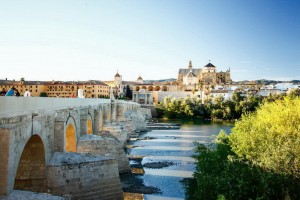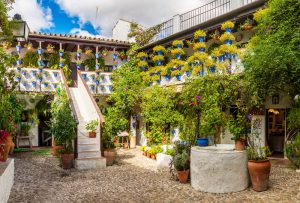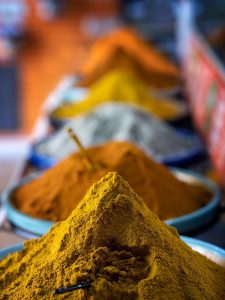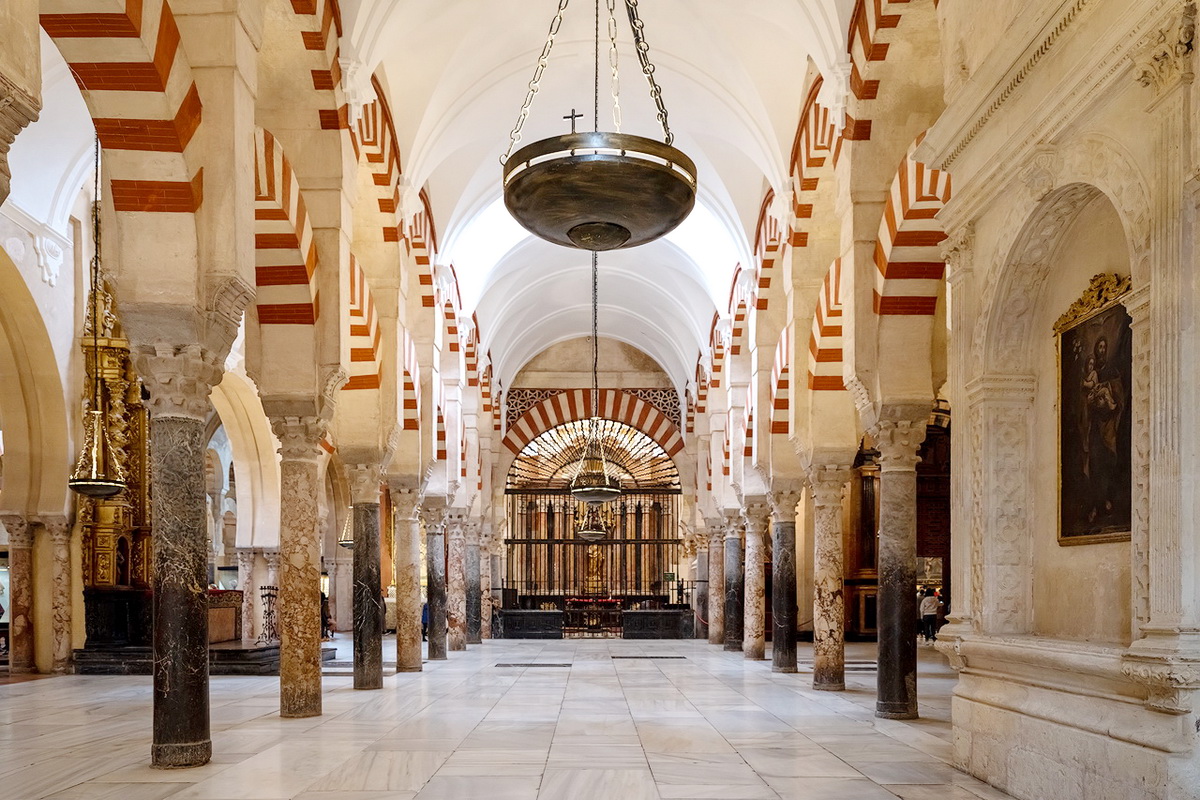
Everything you need to know for 2 or 3 days in Cordoba
There are so many things to see and do in Cordoba we usually recommend at least 2 nights in the city whether visiting on a short break or as as part of a broader tour of Andalucía . Here’s our guide covering all the Cordoba highlights…
As capital of the vast Caliphate of Cordoba the city was Europe’s most populous and also its greatest centre of learning. Prior to that Cordoba was chosen by the Romans as capital of Hispania Uterior. Understandable then that the whole central area is now declared a UNESCO World Heritage site!
The Great Mosque, the largest Islamic edifice in the western world, is undoubtedly the main attraction. Truly breath-taking in both style and scale, here you can see the passing of empires with vestiges of Visigothic and Moorish times as well as the stamp of the Reconquista in the form of the Renaissance cathedral nave built in the heart of the original Islamic mosque.
But there’s plenty more besides; get lost in the labyrinth lanes of the Jewish Quarter and don’t miss the beautiful patios literally festooned with potted geraniums. Visit the Roman walls and bridge or the archaeological remains at Medina Azahara.
Table of Contents
Cordoba Highlights – 9 things to see and do in Cordoba
- The Great Mosque- Cathedral of Cordoba
- Alcázar de los Reyes Católicos
- Callejón de las flores
- Roman Bridge
- Calahorra Tower
- Bridge Gate – Saint Raphael´s Triumph – La Albolafia Mill
- Bishop´s Palace
- Old city gates and Jewish Quarter
- Patios of Cordoba
Things to See and Do in Cordoba Province – Out and About
Practicalities – Frequently asked questions about things to see and do in Cordoba
Cordoba Highlights
The Great Mosque – Cathedral of Cordoba
A labyrinth of columns and cultures
As complex as its vast history, the Mosque-Cathedral of Córdoba (also known as the Great Mosque of Córdoba) is the largest Islamic edifice in the western world.
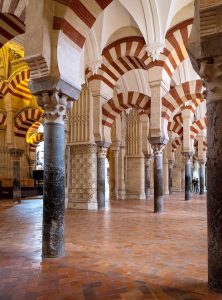
From then on, it has witnessed firsthand the passing of the Visigoths and the Moors as well as the stamp of the Christians during and after the Reconquista. Truly awe-inspiring, the Great Mosque has become a symbol of how the overlaying of civilizations can create such a masterpiece.
Both style and scale coexist here in total harmony giving us the opportunity to enjoy art beyond religions or faiths. Any attempt to describe it in these few lines would be impossible, so go and live it out!
Alcázar de los Reyes Católicos
A royal residence for centuries
Often overlooked in favour of the Great Mosque, the Alcázar de los Reyes Católicos is one of the most outstanding constructions in Córdoba.
In its origins, it was residence of Moorish caliphs and a strategic point due to its location, next to the Guadalquivir river. In 1328, the Catholic King Alfonso XI ordered the construction of a royal palace using parts of the original remains. As a result, a great Mudéjar style building was erected with its towers, delightful gardens and a Moorish bathhouse.
It has had different uses throughout its history and it has witnessed its fair share of important historical events. From defensive fortress during the Civil War in the 15th century to official headquarters of the horrifying Inquisition -even the baths were converted into torture chambers-, it was also here where Christopher Columbus was received by the monarchs to present his plans of the historical trip that turned out to be
the discovery of América.
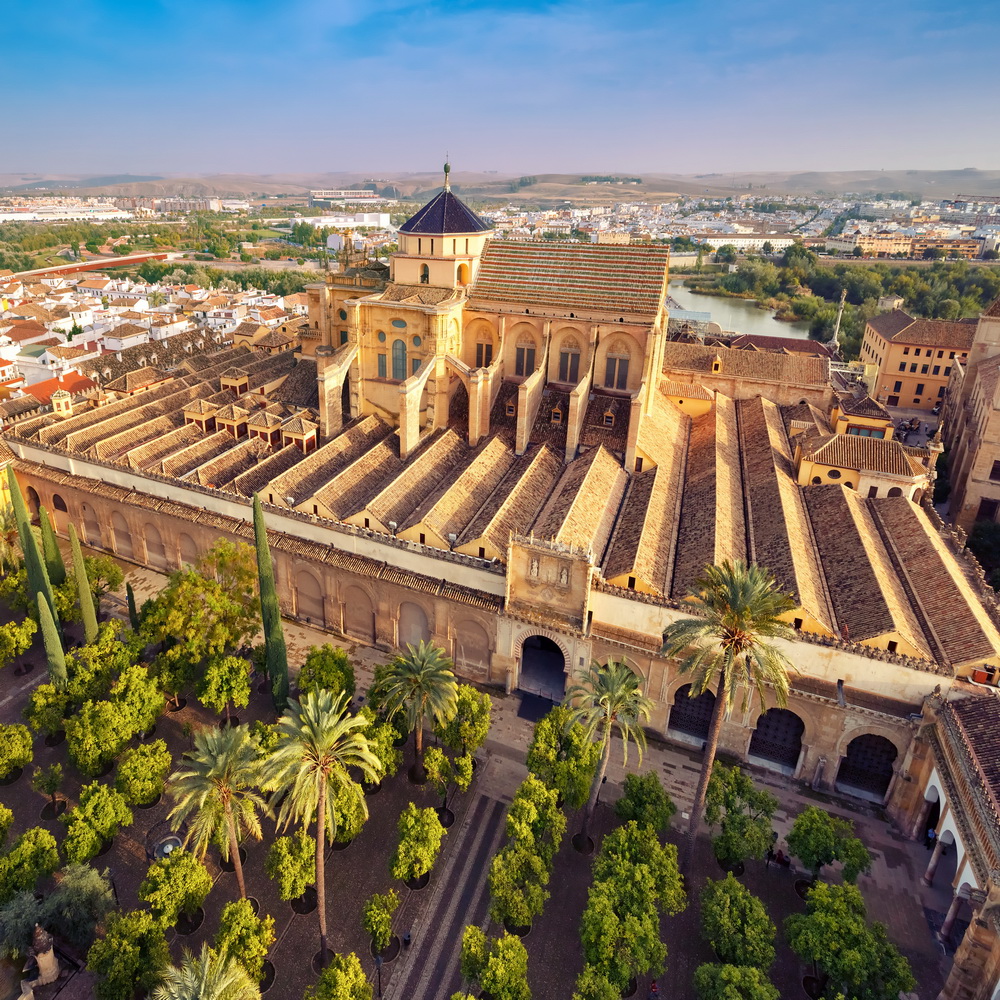
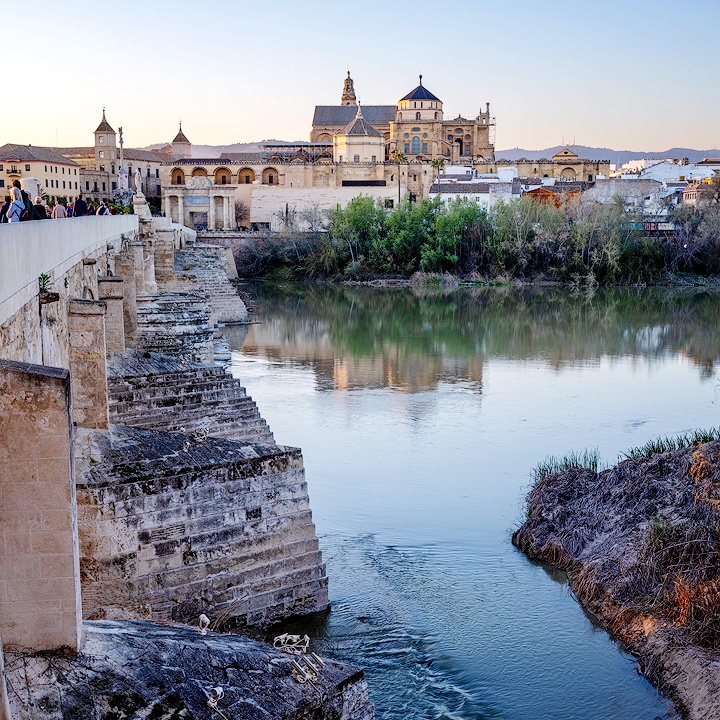
Callejón de las flores
Just a few meters from the Great Mosque, you will find another icon of the city. Though small and narrow, the Calleja de las Flores (Alley of the flowers) won’t go unnoticed by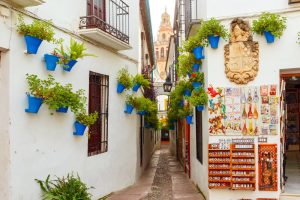
Between the old mansions, its balconies and the walls literally festooned with potted geraniums, this alley offers a perfectly framed view of the Mosque’s belfry tower.
Don’t miss the opportunity to get your own natural souvenir of the city!
Roman Bridge
A path of history
As you leave the Great Mosque in the direction of the river, you will come across the outstanding Roman Bridge, built by the Emperor Augustus as part of the Via Augusta – though only the design and the foundations are preserved from Roman times.
With 230mt and 16 arches, it was an important entry point of the city and due to the fragility of the material used in its construction, it has undergone several modifications.
In 1651, an image of Saint Raphael, who according to legend had promised to watch over the city, was located in the bridge. As evidence of the devotion the people of Cordoba feel for him, it is surrounded by lots of red candles all year round.
Calahorra Tower
At the south end of the Roman Bridge is the Calahorra Tower, built by Henry II in 1369 on the remains of an earlier fortified gate from Islamic period. Although its original function was to reinforce the defensive system of the city, it has had others along its long history.
During part of the 18th century it was a prison, in time of epidemics sick people were put in quarantine here and in the 19th century, it was even used as a school for girls.
It currently houses the Alive Museum of Al-Andalus which offers a permanent exhibition dedicated to the three cultures that lived together in the city: Christian, Muslim and Jewish.
Bridge Gate – Saint Raphael´s Triumph – La Albolafia Mill
As a walled city, Cordoba had numerous entrances being the Gate of the Bridge one of the most important one. 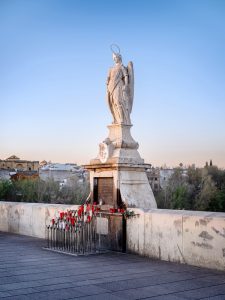
Next to the Bridge Gate stands the Triumph of Saint Raphael, the largest and most representative monument – among the many “triunfos” that you will find throughout the city-dedicated to the glory of the archangel.
A little further ahead, along the riverbed, you will discover another historic jewel of Cordoba: the Albolafia mill. Together with others constructed here, it was designed to supply water to the former Palace of the Emirs. Unfortunately, its waterwheel is not the original since Isabel the Catholic ordered it to be demolished due to the disturbing noise it made.
Bishop´s Palace
First the residence of the Visigoth governors and then Alcázar of the caliphs, this construction became the Bishop´s Palace when Ferdinand II gave it to the Bishop of Córdoba in 1236.
It is built around an arched courtyard and, though its original structure underwent several changes between the 15th and 19th century, some of the Moslem architecture still survives.
Since 1989 it has housed the Diocesan Museum of Fine Art displaying an interesting collection of religious artefacts, artistic treasures and furniture dating back to medieval times.
Old city gates and Jewish Quarter
Jewish legacy in old Cordoba
Though many of the old city gates have been destroyed over the centuries, some of them can be still admired along the remains of the old city walls near the Alcázar gardens. 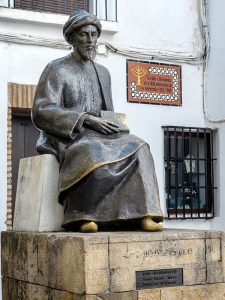
As soon as you cross the Almodóvar Gate, you enter the Jewish Quarter where you will be taken back in time by the labyrinthine, narrow streets. In Calle Judíos, the Synagoge is a must. Apart from the two preserved in Toledo, it is the only ancient synagogue to have survived the expulsion of the Jews in 1492.
Following these streets, you will come to some other places of interest such as the Zoco or market, the Casa Andalusi, the Monument to Maimonides and the Municipal Bullfighting Museum, among others.
Patios of Cordoba
A world of colours and scents
The Cordovan courtyards (patios) are, with no doubt, one of the most picturesque elements of the city.
In Roman times, the traditional house design was adapted to the hot, dry Cordovan climate by building the houses around an open space with a fountain and a well in the middle to collect rainwater.
Later on the Moors gave the house an entrance through a porch and filled the “patios” with plants and flowers. While wandering around the old quarter, you can glimpse these fantastic spaces overloaded with potted geraniums; sometimes half hidden like secret treasures but, many of them open to public.
Guided tours to the most characteristic “patios” are offered all year round, but maybe the best time to enjoy them is the first week of May when the Festival of the Courtyards – organized since 1921 – takes place. A feast for the senses!
Things to See and Do in Cordoba Province
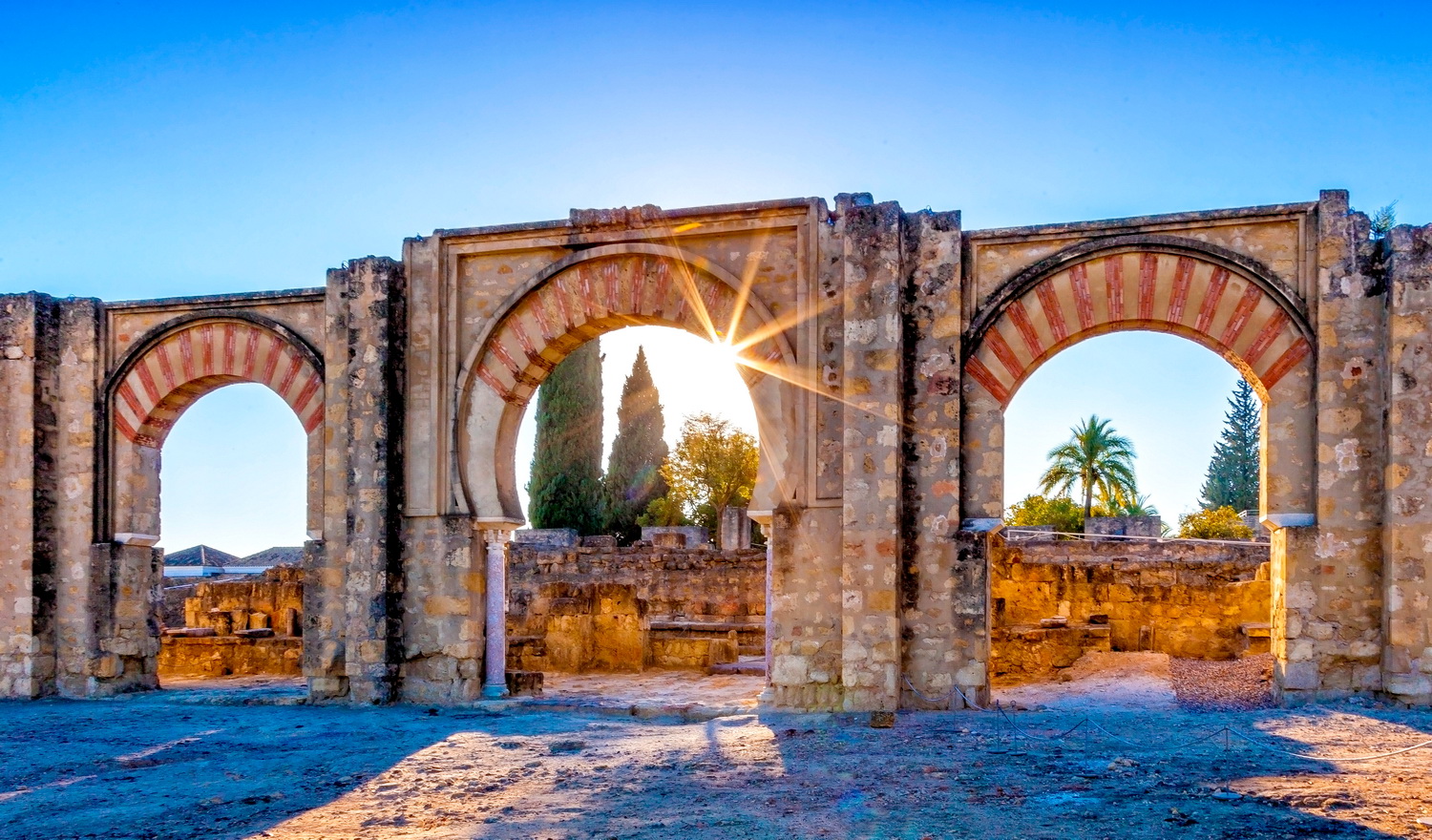
You may well feel that the sights of the city of Cordoba are so enticing that you won’t find the need to explore further, but should you get the urge, the beautiful mountainous area known as La Subettica with its castle crowned villages and towns, set amidst never ending olive groves, in the southeast of the province, is well worth venturing to.
Medina Azahara
A true gem of Al-Andalus
In the outskirts of Córdoba – 7kms from the city – lie the ruins of the ancient city of Medina Azahara. Built by Abderraman III between 936 and 976, it was conceived as the new seat of government and royal residence of the caliphate and, along with the Great Mosque, it is one of the largest monuments in the Hispanic-Muslim legacy in Al-Andalus.
Thanks to the archaeological and preservation works carried out since 1910, in Medina Azahara (also known as the Bright City) you can still admire part of its complex urban structure, sections of the citadel, the mosque, gardens, terraces and some of the rooms and their decorative richness.
Do not hesitate to hire a guided tour and find out more about this fabulous site, once the symbol of the Caliphal magnificence.
Priego de Cordoba
The City of Water
On the “Ruta del Califato”, in the beautiful Parque Natural de la Subbetica, the pretty town of Priego de Cordoba, just over an hour from the capital, certainly deserves a visit. Known as “the city of water” because of its many springs and as “the jewel of the Baroque” thanks to its abundance of outstanding baroque churches and civil buildings, it is a prosperous olive farming town (its olive oil is amongst the best in the world), refreshingly not just relying on tourism.
However there is much to be seen – the flower filled old Muslim quarter “Barrio La Villa”, a sight for sore eyes, the elegant 1780s fountain “ Fuente del Rey” with its 139 spouts, the 16th century old slaughter house “ Las Carnicerias Reales” with its winding stone staircase, the Moorish castle and of course all the magnificent churches, the Parroquia de la Asuncion, being the highlight. Don’t miss the magnificent view of the surrounding countryside from the large natural balcony of the Adarve.
Zuheros
Moorish legacy in Cordoban lands
Northwest of Priego, Zuheros, with its C9th Moorish castle perched dramatically high on a hill with a sea of olive trees down below, is said to be one of Spain’s most beautiful villages. Picturesque, it most certainly is with its white -washed houses, narrow cobbled streets and glorious displays of potted flowers. Yet its charm lies in its simplicity and its ties to tradition and the warmth of its people.
At four kilometres is the Cueva de los Murcielagos (Cave of the Bats) inhabited 35,000 years ago by the Neanderthals. Admire its rock paintings and its stalactites and stalagmites.
There are superb walking routes from the village too including the Via Verde de Aceite along old railway lines, great for both cycling and hiking. If you visit in September, Zuheros holds a “feria de quesos” (cheese fair) where you can sample the excellent goat’s cheeses from the surrounding area.
Montilla
Wine, olive oil, monuments and much more…
As you leave Córdoba heading south, the undulating vineyards will welcome you to Montilla, the geographical centre of Andalucia. Famous for its excellent Montilla-Moriles wines (careful with these, they’ll knock your socks off!) and olive oils, it is a busy town with a local silver and leather industry and workshops where oak wine casks are still made by hand.
Montilla also boasts interesting monuments such as the castle – a former Moorish citadel and birthplace of the renowned “Great Captain”, numerous palaces, churches, hermitages, convents and museums. Feel free to walk through its streets with white houses, visit its old bodegas (Alvear original winecellar is the oldest one in Anadalucia) and submerge yourself in a past of splendour.
Lucena
Discovering the Bética route
In the fertile lands bordering La Campiña and the Sierras Subbéticas and next to the ancient Bética route is set the village of Lucena. Its history, heritage and impressive surroundings make it a special place you shouldn’t miss.
One of Lucena´s landmarks is the Castillo del Moral, a fortress built in Moorish times where Boabdil “El Chico”– last king of Granada – was imprisoned. After the Christian conquest, it was converted into the palace of the Dukes of Medinaceli and today it houses the Municipal Tourist Information Office and the Archaeological-Ethnologic Museum. The Church of San Mateo with its Chapel of El Sagrario – one of the most important baroque works in Andalucia -, the Palacio de los Condes de Hust in the old Jewish Quarter and the Iglesia y Hospital de San Juan de Dios, among others are also worth a visit.
Los Pedroches
An Aunthentic Andalucian Experience
At the heart of the Sierra Morena, the high plain of Los Pedroches, Spain’s largest ‘Dehesa’ (oak forest where pigs are lovingly reared for the famous Iberian ham) opens up. One of the ancient passes between the Spanish Meseta and the Guadalquivir Valley, nowadays it’s one of Andalucía’s poorest regions though certainly not without its charm with a unique, tranquil landscape dotted with white villages, far from the tourist crowds.
Eat, Drink, Dance, Nap
Eating and drinking in Cordoba
Cordoba’s cuisine is an interesting fusion formed by the different civilizations that inhabited the city and province over the ages. Based on olive oil and garlic, both used in Roman times, the Arabs and Jews added spices and sugar to create so many of the dishes we can sample here today.
Eating out is mostly done in typical bars and “tabernas” serving traditional tapas and raciones, often in a colourful plant filled patio at the back. Locals tend to make a meal of these, hopping from bar to bar, choosing between three size options – tapas, media raciones or raciones – the choice is yours! More often than not, these are accompanied by the local Montilla – Moriles, similar to a sherry and made by the same process, but without being fortified. There is fino, amontillado, oloroso and palo cortado and the sweet liqueur wine, Pedro Ximenez, often served straight from the barrel.
Typical Cordoban dishes well worth trying are “salmorejo”, a thicker, creamier version of gazpacho, decorated with finely chopped egg and jamon, “berenenjas con miel”, fried aubergines served with honey, “flamenquines”, pork fillet stuffed with cheese and jamon and fried in breadcrumbs, “rabo de toro”, oxtail stew, “alcachofas a la Montillana”, artichokes cooked in white wine and “mazamorra de almendra”, cold garlic soup. Game from the Sierra Morena and superb cured hams and sausages from Los Pedroches feature widely too and “caracoles”, snails, are a Springtime speciality.
The sweet toothed will not be disappointed either with tempting pastries like “alfajores”, “pestinos” and “pastel Cordobes”, honey, nuts and anise amongst the ingredients.
Flamenco – True Andalucian art in Cordoba
As a true Andalucian city, in Cordoba you can find a variety of tablaos (dance floors where flamenco is performed). Some with twice or even thrice nightly shows of usually about an hour long. The performers change regularly. There’s much debate over which is the most authentic flamenco experience but in some part it’s tourism that keeps this fascinating art form alive – so we say ‘go with the flow’!
Taking it easy in Cordoba
Our top tip for getting the most out of your visit
Cordoba’s such an exciting city with so much to see and do whilst at the same time having one of the hottest climates in Europe – which can easily be an exhausting combination!
We recommend you ‘go native’ and take time and head indoors for a decent rest in the hottest hours of the day.
This is especially true in the summer but will help you adjust to the local rhythms at any time of the year. It’s easy to burn out and be heading to bed before the locals have come out to play of an evening, and you really don’t want to miss the genuine buzz of a Cordoban tapas bar!
Frequently Asked Questions about Things to See and Do in Cordoba
How to get to Cordoba?
When to go to Cordoba?
A visit to Córdoba is best enjoyed in the Spring or the Autumn. From mid-March through to early July then from September through to mid-November.
At the height of summer temperatures can often reach the low 40s Centigrade – so best avoided unless you really like the heat (though with air-conditioning and a siesta it can be made possible, and the city is at its quietest).
The winter months can be quite cool but the average temperature ranges between lows of 5ºC and highs of 15ºC – so a good time to see the city without the crowds. Take care if combining with Granada however as that city is at a much higher altitude and can see some snow!
How long to stay in Cordoba?
We normally recommend two nights when taken as part of an Andalucía touring holiday though, if you have more time, there’s no end of things to see in the city and you could also take an excursion to nearby Priego de Cordoba, Zuheros, Montilla or Lucena.
And don´t miss the ruins of the ancient city of Medina Azahara! You can hire a guided tour and find out more about this magnificent symbol of the Caliphal Period.
What to eat in Cordoba?
As mentioned above (check Eating and Drinking in Cordoba), the cousine of Cordoba is a delightful fusion resulting of all the civilizations that occupied the region.
If you are eating out, got to the traditional bars and tabernas offering tapas and raciones.
Typical “salmorejo”, “berejenas con miel”, “flamenquines” and many other mouth-watering local delicacies are well worth trying. All topped up with the tempting “alfajores”, “pestinos and “pastel cordobés”…a delight for the sweet toothed for sure!
What to buy in Cordoba?
Like in any tourist city, you will find plenty of souvenir shops selling all kind of typical bric-a-brac, but if you want to buy a more unique and authentic pressie, there is also a lot to choose from.
The yellowish tones of La Rambla´s clay identifies the old pottery tradition of Cordoba. Either functional or decorative pieces painted by hand are an interesting option.
Leather is also one of the main local specialities of the city. From bags, purses, wallets and belts to the finest embossed and coloured pieces, you can find them all in the several specialised handcraft worshops of the Jewish Quarter.
If you want to treat yourself or your partner, be aware that one of the finest silver jewels of the world have been produced in Cordoba for centuries. Not to mention the famous and stylish Cordobes hat which you can buy at any of the family-run shops opened now for decades in the city like Sombrerería Herederos J. Rusi…
And last but not least, the famous Montilla-Moriles wines, Predoches hams and other delicacies are a safe bet for the loved ones!


